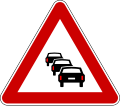
Road signs in Saudi Arabia are regulated in the 2007 Traffic Law. [1] Road signs in Saudi Arabia follow the Vienna Convention on Road Signs and Signals, to which it acceded on March 31, 2022, [2] [3] and display text in both Arabic and English. Distances are displayed in metric units and in Eastern Arabic numerals.
Contents
- Warning signs
- Regulatory signs
- Guide signs
- Temporary signs
- SHC 602 signs
- Modified signs
- New signs
- References
In 2023, the Saudi Highway Code 602 - Manual on Uniform Traffic Control Devices was published as part of the Saudi Vision 2030 government program. [4] This manual introduced several new signs and modified various existing signs, most notably by mandating that new signs shall only display Western Arabic numerals.
According to SHC 602, Arabic text should be rendered in Naskh script, while the Transport typeface should be used for English text. [4] Prior to this manual, both Highway Gothic and Helvetica were used for English text.





































































































































































